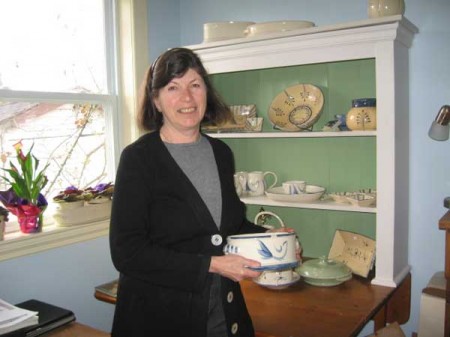Thirty years ago, looking for something to do in the evenings, I tried my first pottery course. I loved it. At the end of that first beginner’s level course, and encouraged by some pots that came out of the kiln actually looking like pots, I decided to do an intermediate course. This time, my enthusiasm lasted only as long as it took me to realize that the instructor was really serious when he wanted me to make four pots the same shape and size! Well, that sure took the fun out of it! Needless to say, I didn’t last long in the class.
Twenty years later, a summer class in Haliburton made me realize that I still loved pottery and, more importantly, that I was finally ready to take on the discipline needed to produce good pots. Not to say that the skill just magically materialized, no- there were a lot pots that never made it off the wheel, let alone into the kiln! – but, over the years, and with much practice, I have managed to hone my skills to the point where I can take a concept and I sit down at the wheel and lo and behold, it works out-usually! (ask any potter, and they will tell you that that, after learning to centre the clay, getting to that point in your skill level is next best to miraculous!)
So many people think that pottery can only be done on a wheel, giving you round shapes and more round shapes. Yet, working with clay is so much more than that and the wheel is only one small part of the equation. I can take a lowly lump of clay and have it come out looking totally different every time if I want – frilly, square, round, oval, – the ultimate shape is only limited by my imagination. (and, of course, after all that practice, I really can do sets of four or eight or twelve identical pieces!). However, even with the knowledge that I can produce a well made pot, there are still many, many things that can go wrong between making the pot and putting it on the shelf to sell.
A teacher once said that pottery is one of the most difficult arts to master, and she was right. You are working with a medium that you can only guess as to how it will turn out. Clay has memory and will twist in the oddest ways if it doesn’t like what you are doing to it. Glazes go on red or brown – but come out blue or green or black, depending on their components and on the type of clay used; fire your work too high or too low and the glaze takes on another colour than what you imagined – and may end up ruining your pot. Unlike painting, you don’t often have the luxury of reworking the glazed pot to make it something else – once the form is set and the colour established, your ability to change it is very limited. Often, you don’t have any real idea of what your work is going to look like until you take it out of that last firing in the kiln. At that point, you may have invested several hours in making, trimming, decorating, bisque glazing, glazing and glaze firing.
Yet it is that very challenge of the unknown that makes pottery so rewarding – when a stunning piece comes out of the kiln, it can be like winning the lottery! If it comes out looking like junk, well there is always the next time….
Suzanne Woods has been making pots seriously for the past ten years and sells her work through her home studio and galleries in the region.



